Many thanks to SWLing Post contributor, Matt Blaze, for the following guest post:
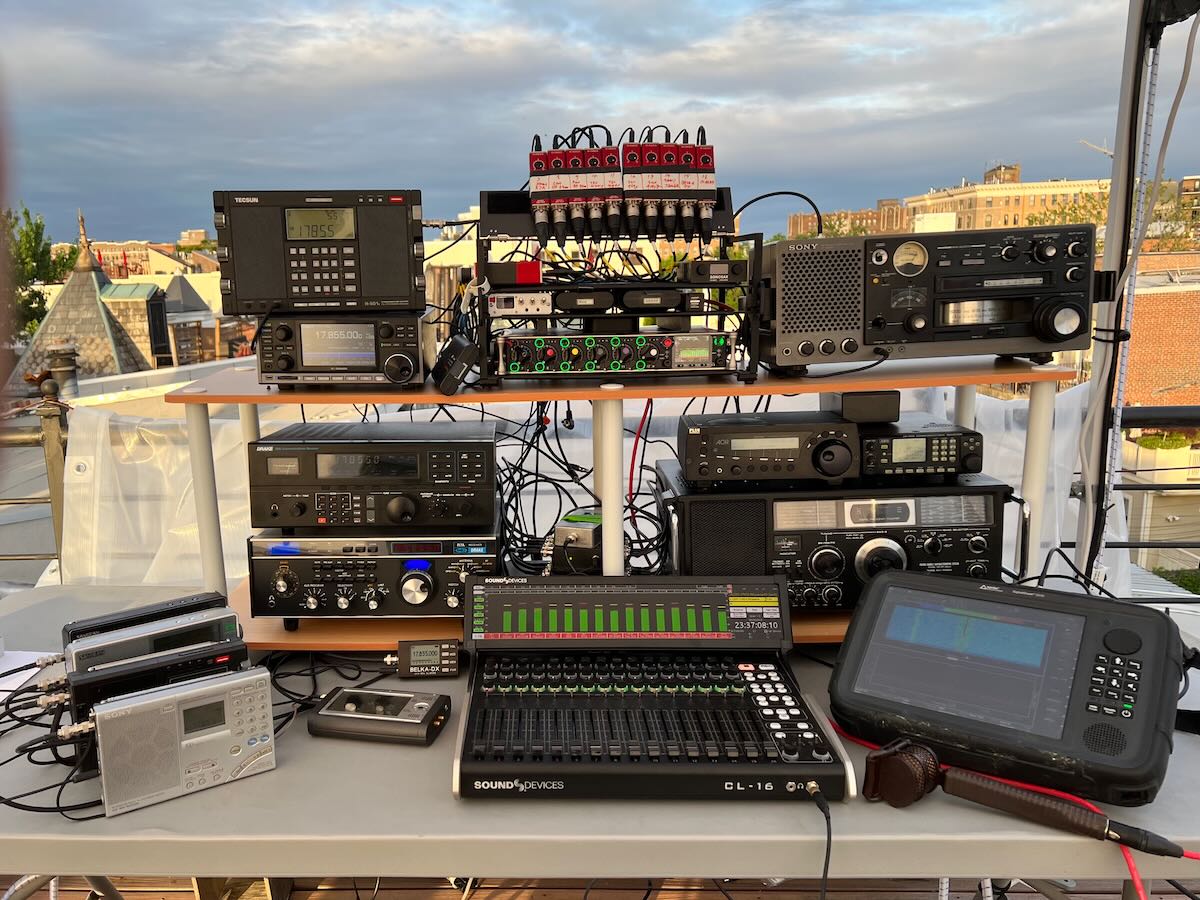 Matt’s Rooftop Receiver Shootout, Round Two.
Matt’s Rooftop Receiver Shootout, Round Two.
by Matt Blaze
You may recall that back in April, I dragged eight of my favorite receivers up to the roof, hooked them up to a portable antenna, and compared their abilities to demodulate various signals at the same time. For the most part, the similarities between radios were more striking than their differences. I hinted that there’d be a second installment to come, including more receivers and more challenging signals, to further expose and highlight the practical real-world performance differences between the radios we use.
So, as promised, here we are with Round Two of my Rooftop Receiver Shootout.
This time around, I used approximately the same setup, but with a total of fifteen different radios. And once again, I took advantage of nice weather and brought a multitude of receivers, recording gear, cables, and an antenna up to my roof to listen to and record shortwave signals under the open sky.
Our fifteen receivers included everything from “dream radios” from the 1980’s to current-production desktop models to less expensive modern portables to high-performance bench-top lab measurement gear. I tried to curate samples of a wide range of radios you may be familiar with as well as some you probably aren’t.
The lineup consisted of:
- Icom R-8600, a current production “DC to Daylight” (or up to 3 GHz, at least) general coverage communications receiver, with highly regarded shortwave performance.
- AOR AR-ONE, another DC to 3 GHz general coverage radio, less well known due to the high price and limited US availability. Excellent performer, but a counterintuitive and awkward (menu-driven) user interface is less than ideal for shortwave, in my opinion.
- Reuter RDR Pocket, a very cute, if virtually impossible to get in the US, small production, high performance SDR-based shortwave portable receiver. It’s got an excellent spectrum display and packs near desktop performance into a surprisingly small package.
- AOR 7030Plus, an extremely well regarded mobile/desktop HF receiver from the late 90’s. Digital but retaining some important analog-era features like mechanical filters. Designed and (mostly) built in the UK, it’s got a quirky menu-driven user interface but is a lot of fun once you get used to it.
- Drake R8B, the last of the much-beloved Drake receivers. Probably the chief competitor to the 7030+.
- Drake R7A, an excellent analog communications receiver (but with a digital VFO) from the early 80’s. It still outperforms even many current radios.
- Sony ICF-6800W, a top of the line “boom box”-style consumer receiver from the early 80’s. Great radio, but hard to use on SSB, as we saw in Round One.
- Panasonic RF-4900, the main competition for the Sony. Boat-anchor form factor, but (improbably) can run on internal D-cell batteries. Generally impressive performer on AM, but, like the Sony 6800, difficult to tune on SSB.
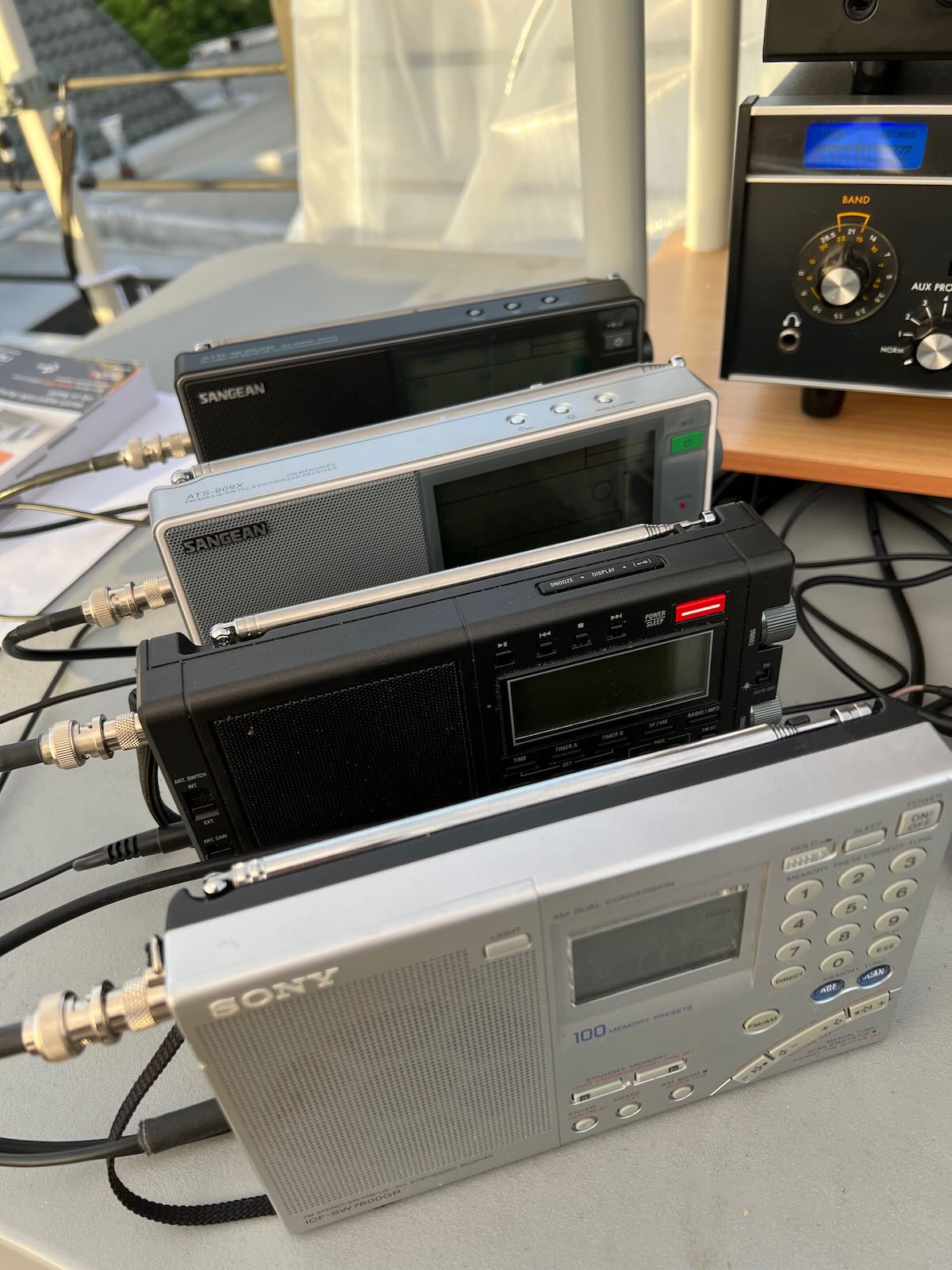 You may remember the above radios from Round One back in April. The new radios this time were:
You may remember the above radios from Round One back in April. The new radios this time were:
- Tecsun 501x, a larger-format LW/MW/HF/FM portable released last year. As noted below, it’s a generally good performer, but regrettably susceptible to intermod when connected to a wideband external antenna (as we’ll see in Part One).
- Tecsun PL-990x, a small-format portable (updating the PL880), with many of the same features as the 501x. Like the H501x, good performance as a stand-alone radio, but disappointing susceptibility to intermod when fed with an external antenna.
- Sangean ATS-909x, a recent LW/MW/HF/FM portable with a good reputation as well as a few quirks, such as only relatively narrow IF bandwidth choices on HF. Excellent performance on an external antenna.
- Sangean ATS-909×2, an updated, current production version of the ATS-909x that adds air band and a few performance improvements. Overall excellent, though I would prefer an addition wider IF bandwidth choice. My go-to travel receiver if I don’t want to take the Reuter Pocket.
- Sony ICF-7600GR, a small-format digital LW/MW/SW/FM portable introduced in 2001 and the last of the Sony shortwave receivers. Showing its age, but still competitive in performance.
- Belka DX, the smallest radio in our lineup, made in Belarus. You’ll either love or hate the minimalist interface (one knob and four buttons). If you’re going to secretly copy numbers stations in your covert spy lair, this is a good radio to use. Can be difficult to obtain right now due to sanctions.
- Finally, a bit of a ringer: the Narda Signal Shark 3310, a high performance SDR-based 8.5 GHz RF spectrum and signal analyzer. As with most test equipment like this, demodulation (especially of HF modes) is a bit of an afterthought. But it has an excellent front end and dynamic range, intended for identifying, extracting, and analyzing weak signals even in the presence of strong interference. Not cheap, but it’s intended as measurement-grade lab equipment, not consumer gear. Demodulated audio is noticeably delayed (several hundred ms) compared with other receivers due to the multi-stage DSP signal path.
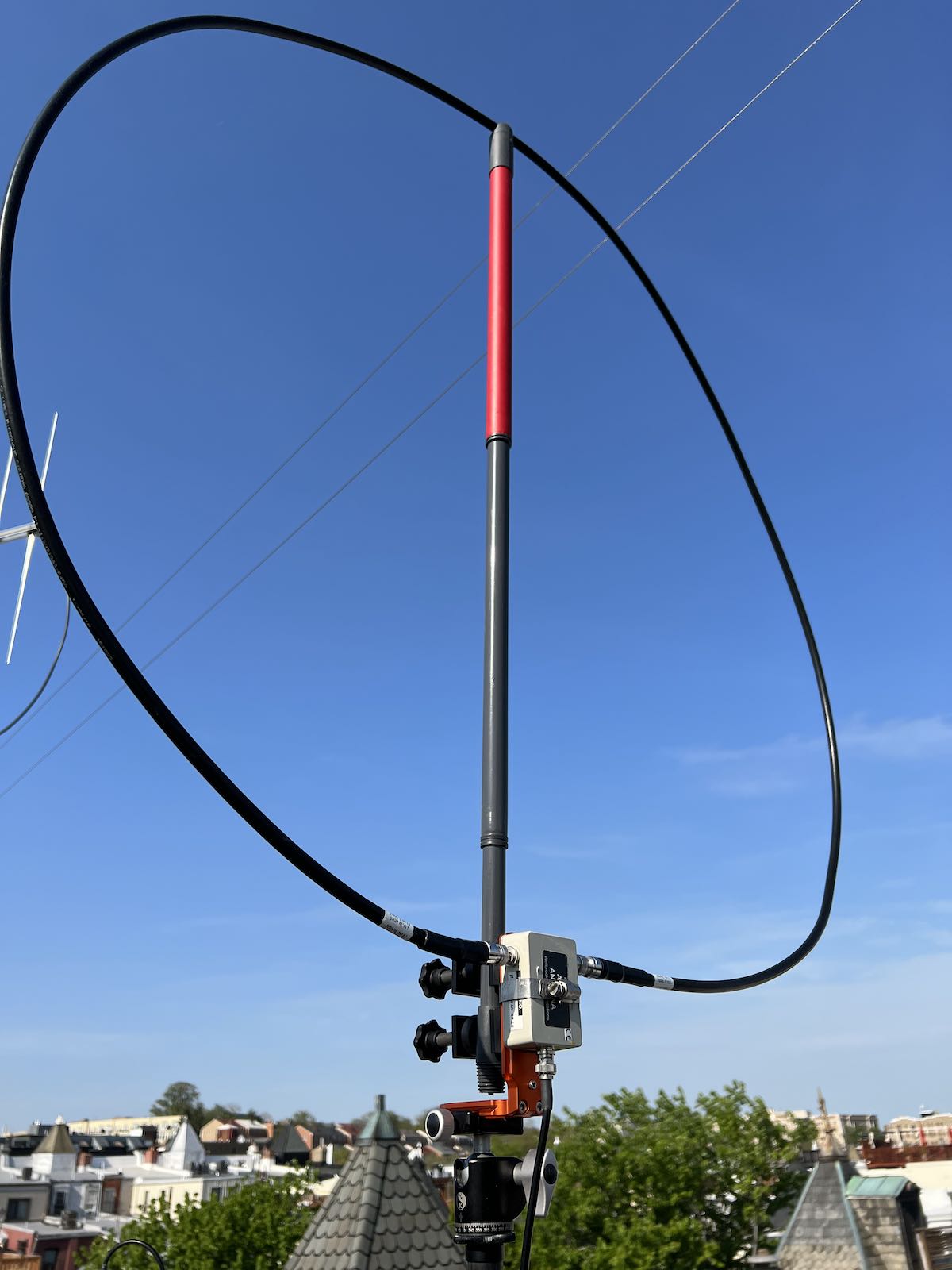
The antenna was my portable “signal sweeper” Wellbrook FLX-1530 on a rotatable tripod, using a power splitter and a pair of Stridsberg Engineering 8-port HF distribution amplifiers to feed the fifteen radios. So every radio was getting pretty close to exactly the same signal at its RF input.
Recordings were taken directly from each radio’s line output jack, if one was available, or from the external speaker/headphone output otherwise. In either case, the audio was fed through an isolation interface and converted to a balanced signal for recording.
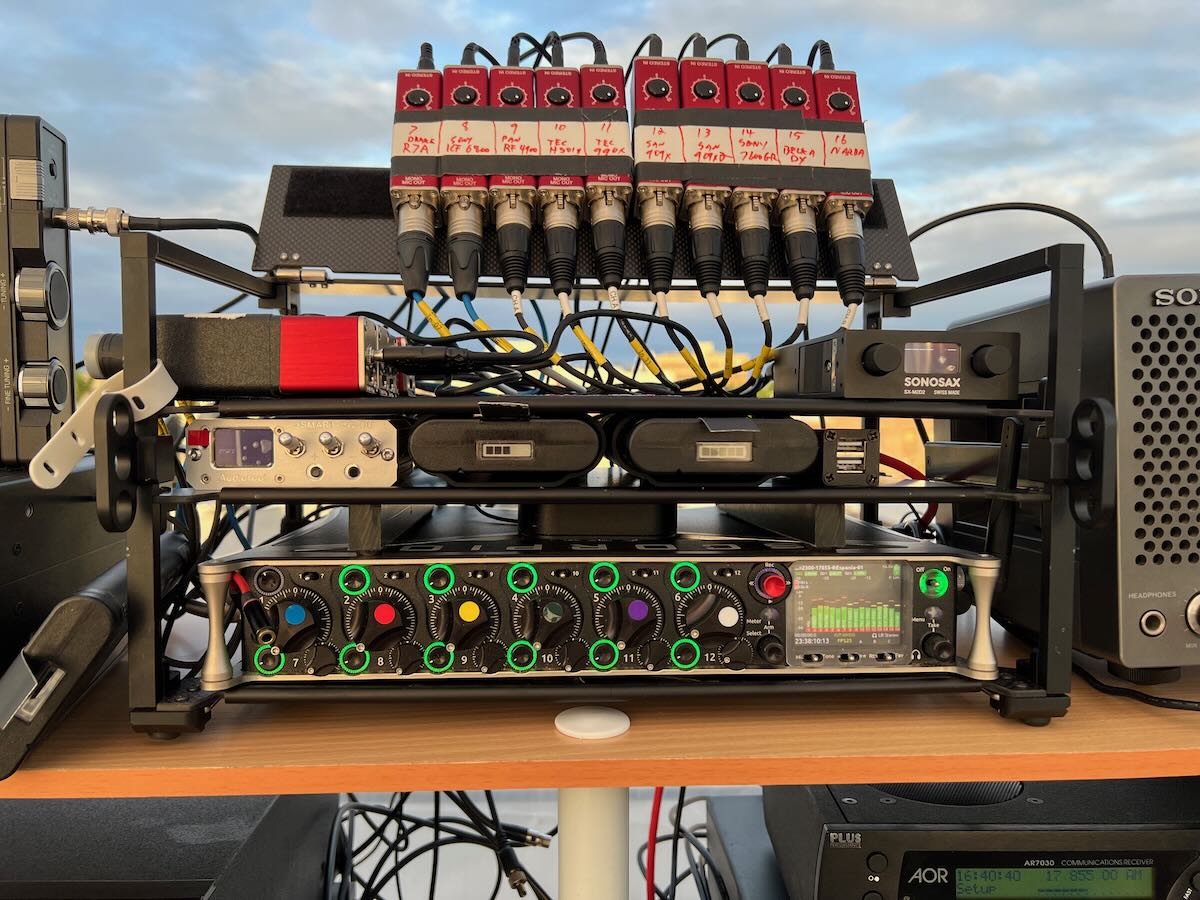 For each of our three signals, I recorded fifteen simultaneous monaural “solo” tracks (one for each radio), as well as a narrated stereo track in which I compared the audio from each radio (one after the other) against the Icom R8600 reference, with the audio from the R8600 on the left channel and the audio from the other radios on the right channel. The stereo track gives you a quick overview of what all the radios sound like.
For each of our three signals, I recorded fifteen simultaneous monaural “solo” tracks (one for each radio), as well as a narrated stereo track in which I compared the audio from each radio (one after the other) against the Icom R8600 reference, with the audio from the R8600 on the left channel and the audio from the other radios on the right channel. The stereo track gives you a quick overview of what all the radios sound like.
The narrated stereo recording requires some explanation if you’ve never listened to one of my comparisons before. For it to make any sense, you MUST listen in stereo, using decent headphones if at all possible. You can switch earpieces back and forth (with your finger on pause and rewind) to get a quick idea of what each radio sounds like compared with a “known” receiver, and how they handle things like fades and static.
The solo tracks, on the other hand, consist entirely of continuous audio from a single radio, with no narration or interruption. You can use them to get an in-depth look at the performance of a particular radio you’re interested in, or to compare different receivers against each other.
As in our previous round in April, I recorded three different HF signals over the course of two days, for a a total of three fifteen-way comparisons. And as with last time, I think both some of the performance differences as well as the similarities may surprise you.
It’s worth noting that this is not intended as a lab test to measure receiver parameters, but rather a characterization of how different receivers demodulate real-world signals in practice, from the antenna jack to the speaker. Measurements of receiver specifications are extremely useful (and widely available as published specifications) for understanding differences in quality, but they don’t always tell us the whole story about how well we’ll be able to understand and enjoy the actual signals we capture.
Part One: A fairly good signal from Spain
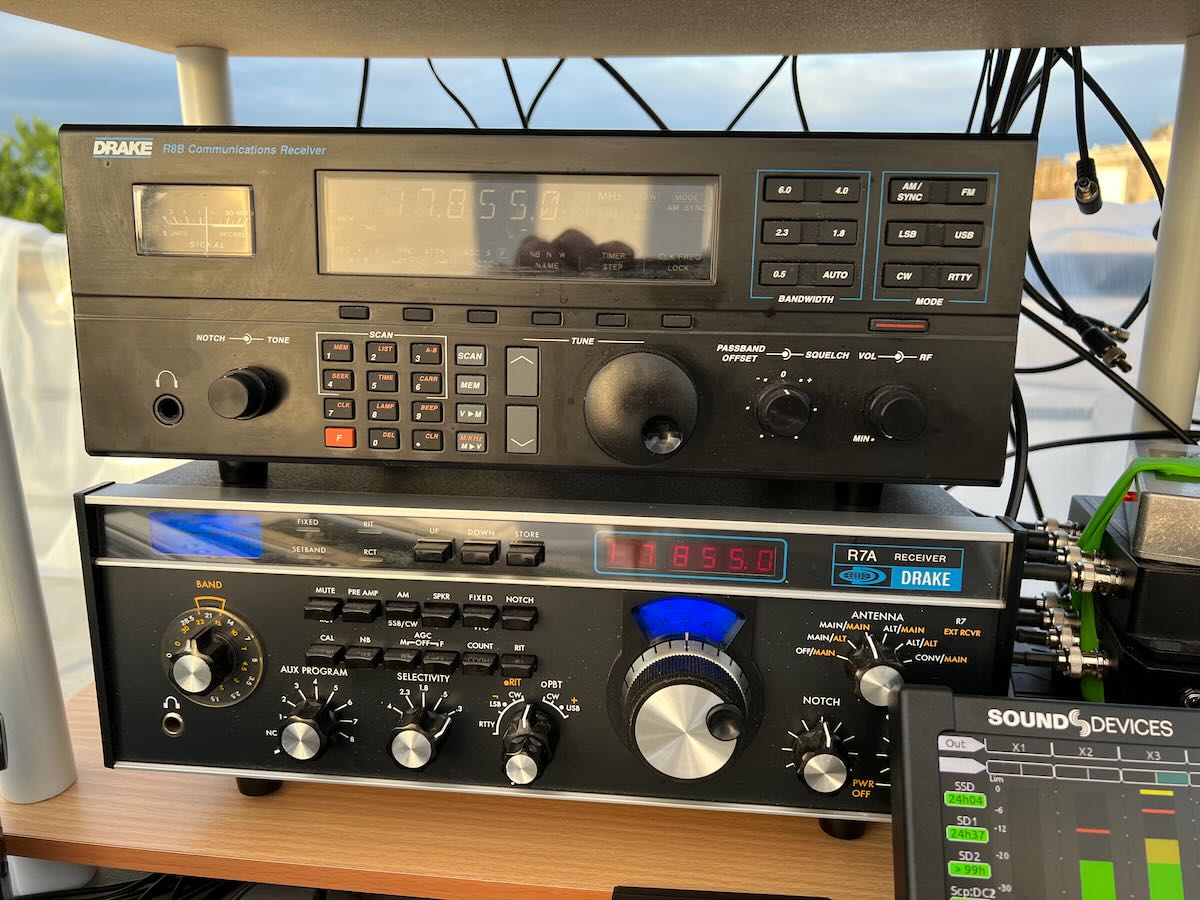 Our first signal was the external service of Radio Espana, captured in the late afternoon on 17855 KHz. The signal was generally good with occasional deep fades. All the receivers had little difficulty demodulating the signal, but there are differences in both audio quality and in the response to and recovery from fades. I set each receiver to the widest reasonable available IF bandwidth (up to 8 KHz), which provided the best overall audio quality.
Our first signal was the external service of Radio Espana, captured in the late afternoon on 17855 KHz. The signal was generally good with occasional deep fades. All the receivers had little difficulty demodulating the signal, but there are differences in both audio quality and in the response to and recovery from fades. I set each receiver to the widest reasonable available IF bandwidth (up to 8 KHz), which provided the best overall audio quality.
Notice in particular the additional station audio occasionally present in the two Tecsun captures (especially audible around 9 minutes in), caused by intermod mixing generated in those receivers (which I was able to reduce but not completely eliminate with the attenuator switch).
Narrated stereo overview mix:
Individual receiver solo tracks:
Icom R-8600:
AOR AR-ONE:
Reuter RDR Pocket:
AOR 7030Plus:
Drake R8B:
Drake R7A:
Sony ICF-6800W:
Panasonic RF-4900:
Tecsun 501x:
Tecsun PL-990x:
Sangean ATS-909x:
Sangean ATS-909×2:
Sony ICF-7600GR:
Belka DX:
Narda Signal Shark 3310:
Part Two: A weak signal from Brazil
 Radio Voz Missionaria is a lower power (5-10 KW) Portuguese-language Brazilian religious station broadcasting over shortwave to remote areas of Brazil. The 9665 KHz transmitter was actually on 9667 KHz (an unusual error for a licensed broadcaster).
Radio Voz Missionaria is a lower power (5-10 KW) Portuguese-language Brazilian religious station broadcasting over shortwave to remote areas of Brazil. The 9665 KHz transmitter was actually on 9667 KHz (an unusual error for a licensed broadcaster).
North America is definitely not in the intended coverage area, but the signal often can be heard here. This evening it was detectable but quite marginal, providing a good opportunity to see how each receiver can or can’t handle signals down near the noise. Most of the radios were able to detect SOMETHING at least some of the time, but with varying intelligibility.
Narrated stereo overview mix:
Individual receiver solo tracks:
Icom R-8600:
AOR AR-ONE:
Reuter RDR Pocket:
AOR 7030Plus:
Drake R8B:
Drake R7A:
Sony ICF-6800W:
Panasonic RF-4900:
Tecsun 501x:
Tecsun PL-990x:
Sangean ATS-909x:
Sangean ATS-909×2:
Sony ICF-7600GR:
Belka DX:
Narda Signal Shark 3310:
Part Three: A moderate signal from Cuba in a crowded band
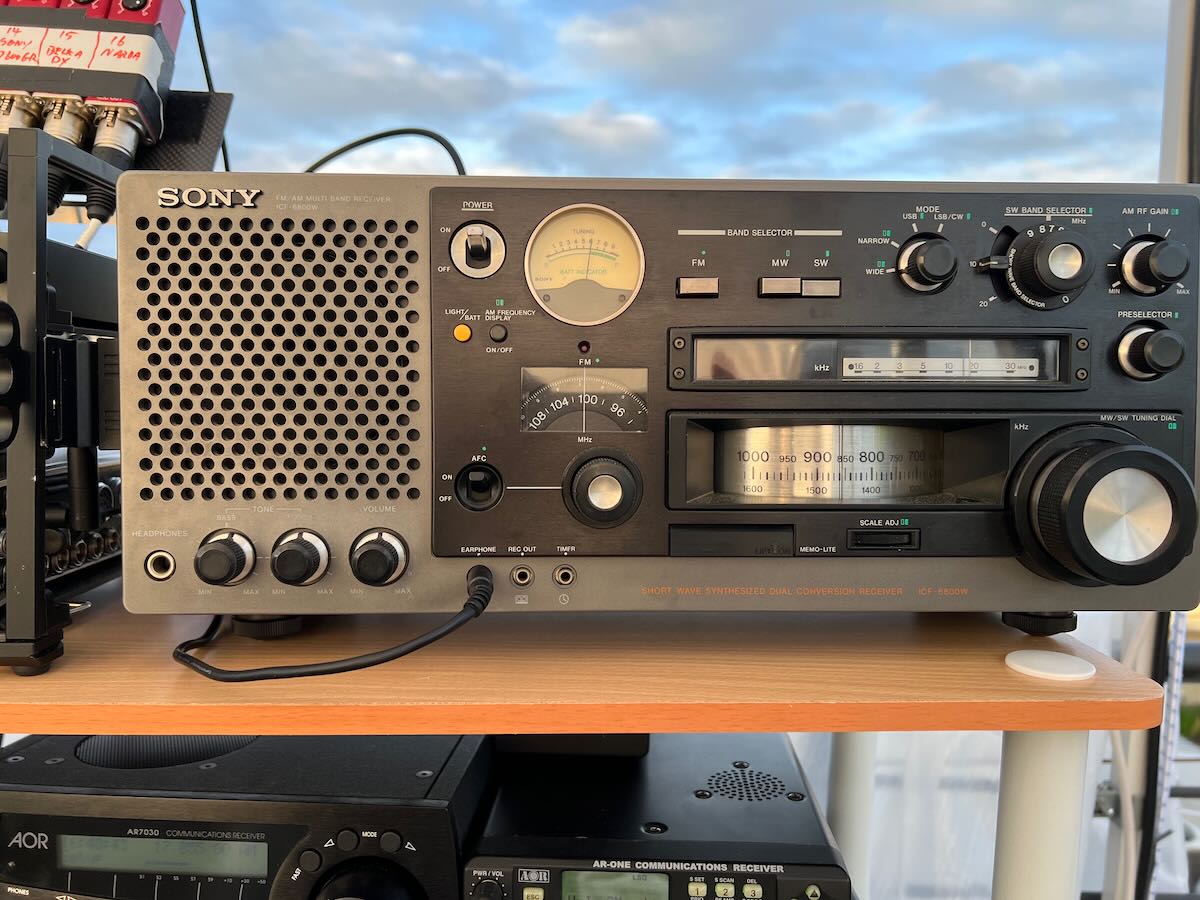 Love it or hate it, Radio Habana Cuba is undeniably one of the most prolific shortwave broadcasters receivable in North America. This evening, their signal on 6165 KHz was reasonably good here, but 5 KHz over, on 6160, was a somewhat stronger signal from WBCQ (which I may have misidentified as WRMI in the narration). This provided an ideal opportunity to listen to the receivers’ abilities to handle adjacent channel rejection under real-world conditions. Receiver bandwidth was set (where possible) to the widest available setting that best avoided spillover from the WBCQ signal.
Love it or hate it, Radio Habana Cuba is undeniably one of the most prolific shortwave broadcasters receivable in North America. This evening, their signal on 6165 KHz was reasonably good here, but 5 KHz over, on 6160, was a somewhat stronger signal from WBCQ (which I may have misidentified as WRMI in the narration). This provided an ideal opportunity to listen to the receivers’ abilities to handle adjacent channel rejection under real-world conditions. Receiver bandwidth was set (where possible) to the widest available setting that best avoided spillover from the WBCQ signal.
Narrated stereo overview mix:
Individual receiver solo tracks:
Icom R-8600:
AOR AR-ONE:
Reuter RDR Pocket:
AOR 7030Plus:
Drake R8B:
Drake R7A:
Sony ICF-6800W:
Panasonic RF-4900:
Tecsun 501x:
Tecsun PL-990x:
Sangean ATS-909x:
Sangean ATS-909×2:
Sony ICF-7600GR:
Belka DX:
Narda Signal Shark 3310:
Some notes on production:
Everything was done on my roof, and took a couple hours to move set up. But the effort was worth it; there’s something about listening to radio in the open air that’s just a different experience. The recordings were captured with a 32 channel Sound Devices “Scorpio” recorder with an SL-16 mixing console. The fifteen radio audio channels were isolated and converted to balanced output with an array of Switchcraft 318 direct interface isolation boxes (well suited for recording multiple radios with pro audio gear). I monitored with headphones to allow critical tuning and to avoid disturbing the neighbors. The recording equipment, like most of the radios, was powered by batteries to help avoid line noise and ground loop trouble.
The stereo track narration was done by me in real time, as the signals were being recorded. There was no postproduction other than converting the various tracks to mp3. I occasional made some comments about receiver performance and other things that might not not always have reflected what I would later conclude after carefully listening to the solo tracks once back inside. But judge for yourself. I used a Coles “lip” microphone, an unusual (and really useful) ribbon mic designed decades ago for the BBC for use in highly noisy environments (and still made today). It was very effective in reducing the sometimes loud street noise, bird songs, and other ambient outdoor sounds of my neighborhood. The mic preamp was a Sonosax M2D2. See the photos for the rooftop setup.
Thanks again for listening and 73!

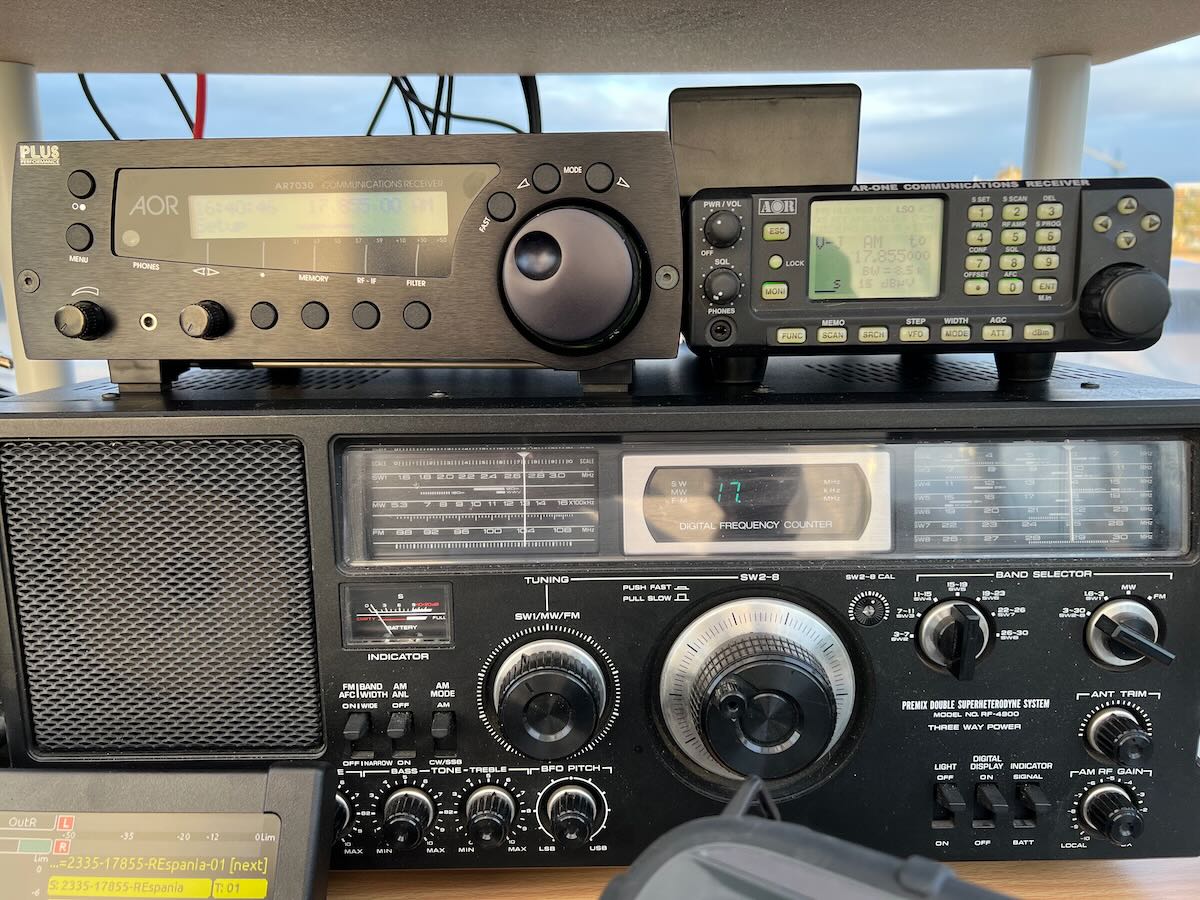
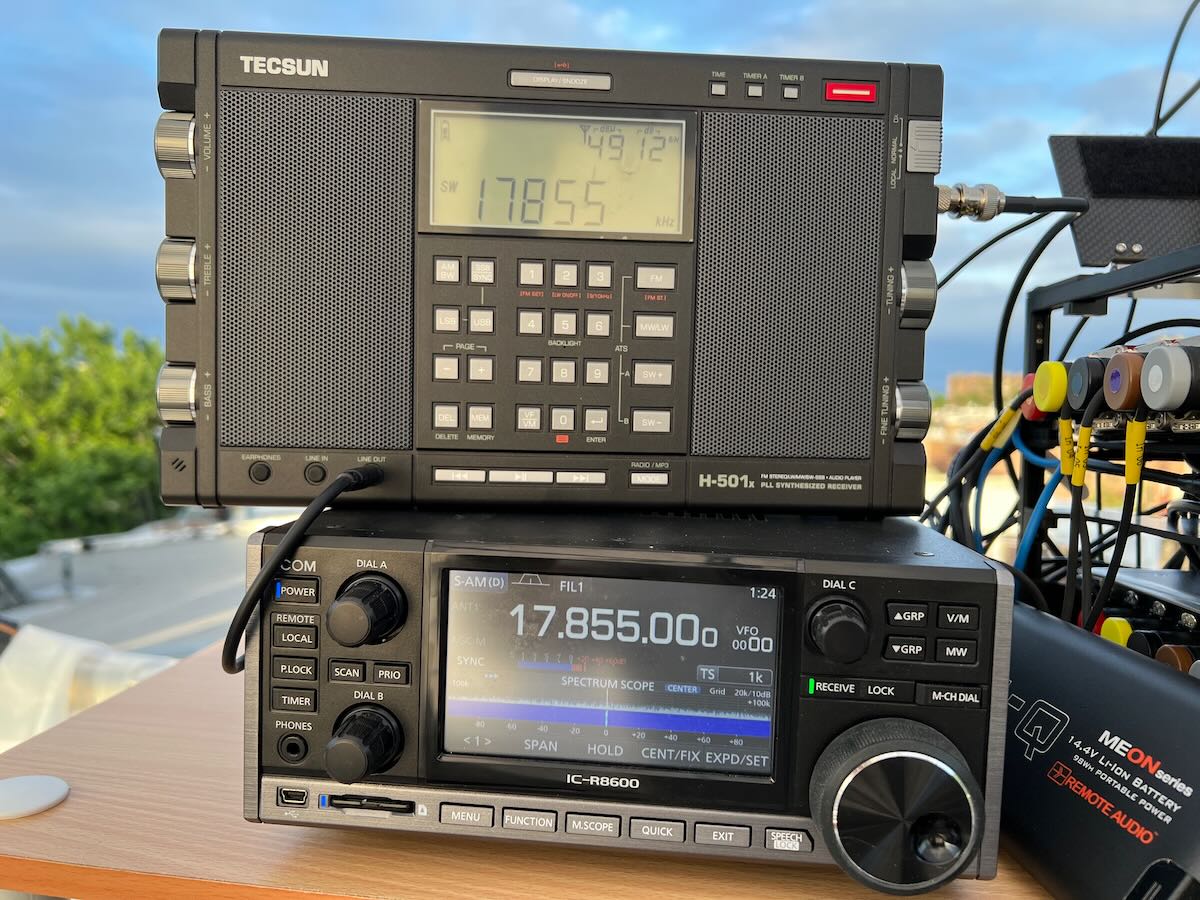
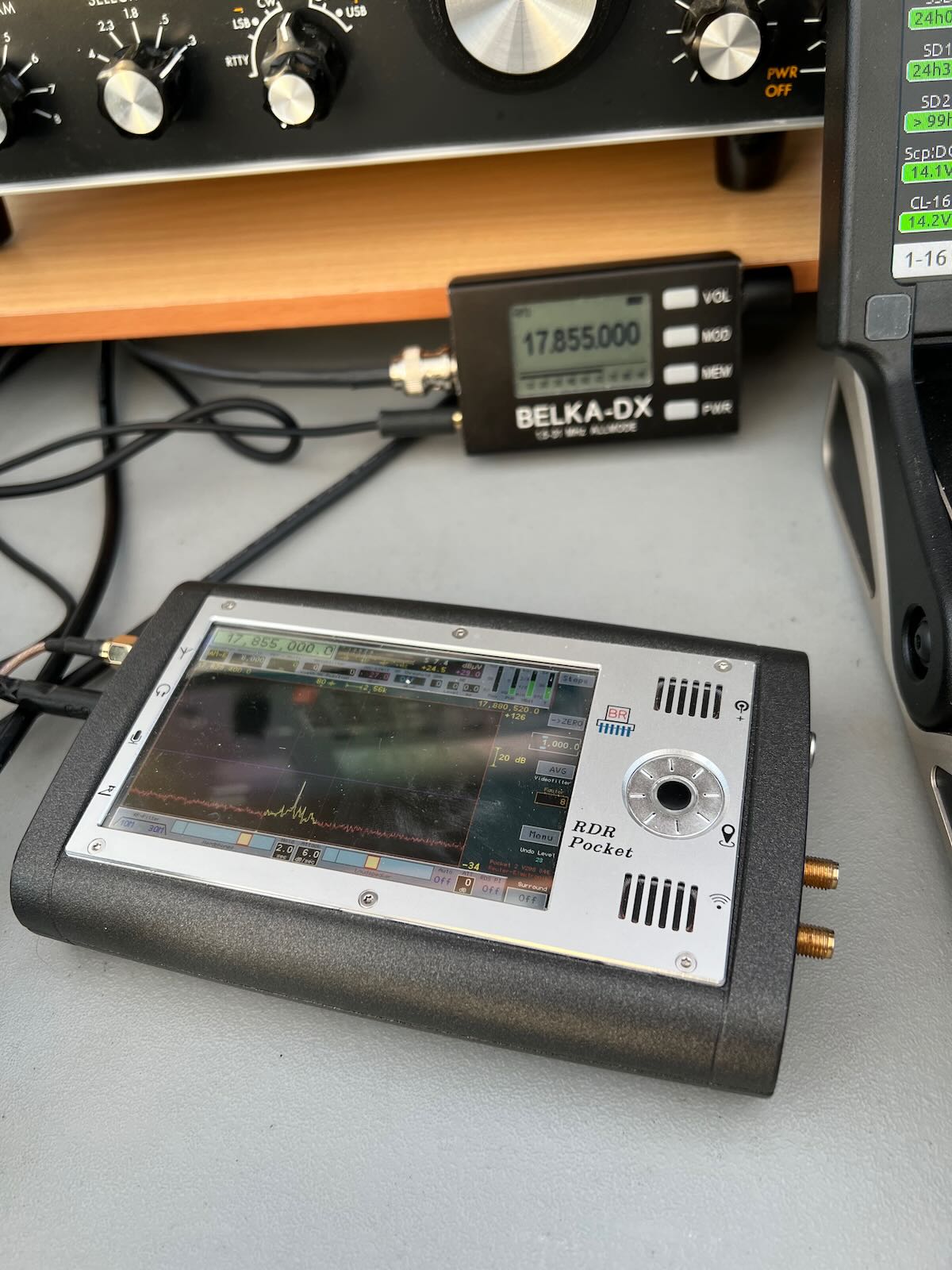
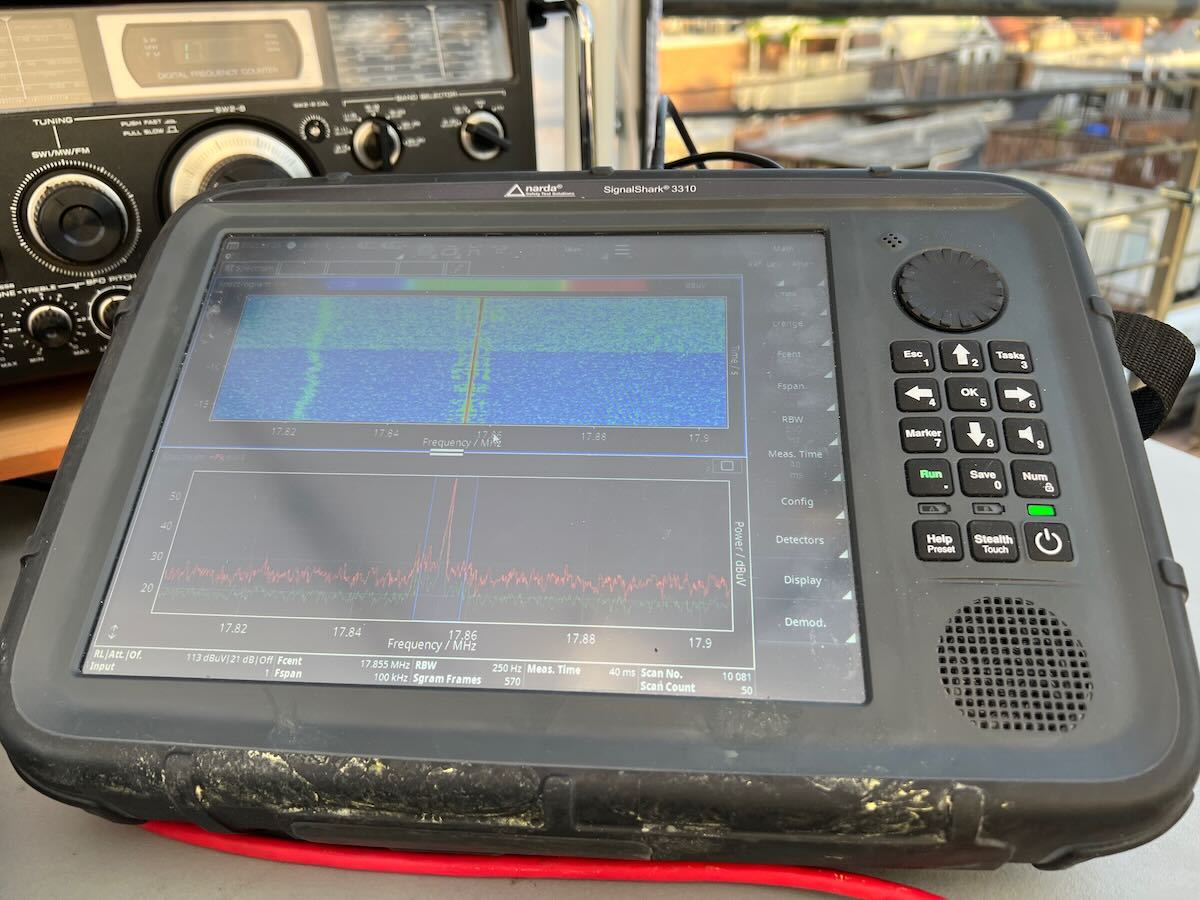
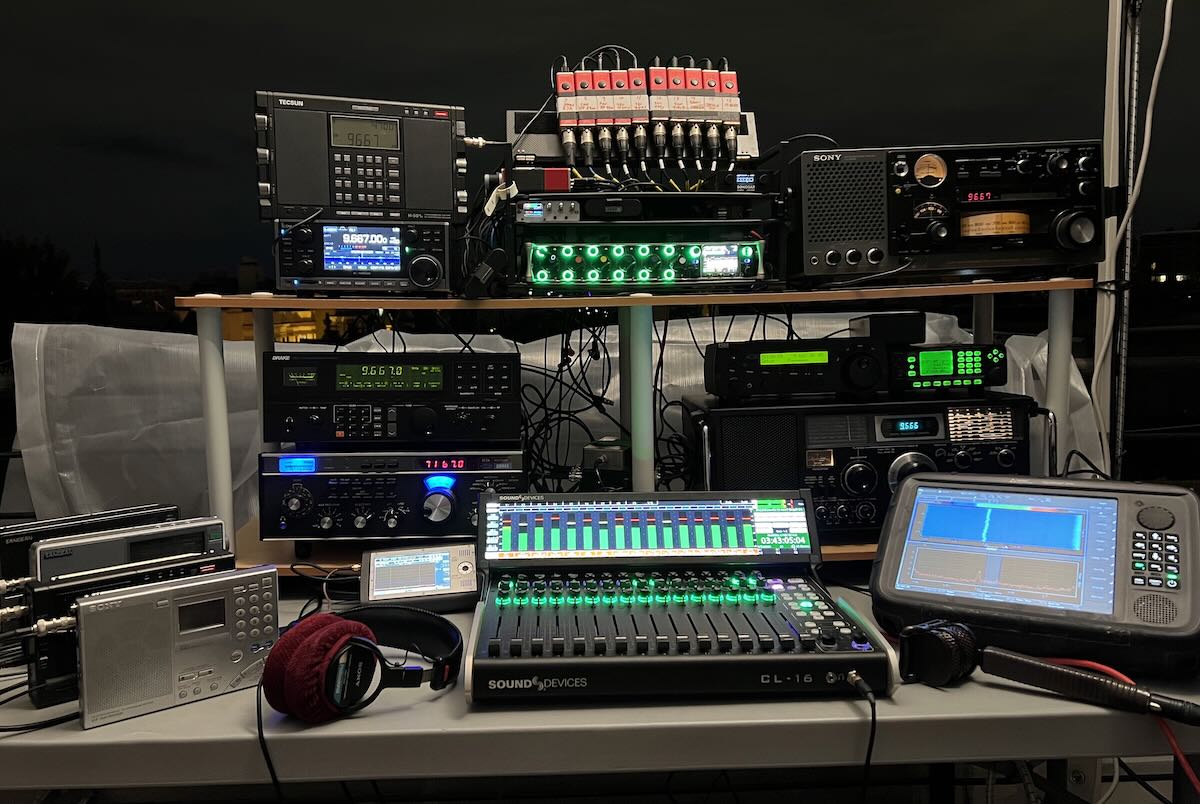
Matt
Thank you for putting in all the hard work to compare these receivers!
It’s a very very useful reference.
A lot of hard work for you, a big dividend for all us SWListeners.
73
Julian
Hi,
I really need a holder or a clamping mechanism for SignalShark 3310 to attach it to the car. Can anyone advise who has or seen such a thing?
Even 3D print is possible but have no skills to drawing the .stl just have 3D printer.
Better if someone have something professional.
Many thanks.
Petr
Especially in part three: did you take advantage of a synchronous detector with selectable sideband on those receivers that have it?
I did, but only if it actually improved the demodulated audio (to my ear) compared with AM with a narrow filter. That left just the Icom and the 7030+ sync detectors as providing any useful advantage in part 3. I should have mentioned that in the writeup; sorry.
Thanks everyone for the kind and generous comments.
It’s notable to me that although these various receivers have very different specifications, with some clearly “better” than others, that doesn’t make nearly the difference you’d think it would when it comes to actually demodulating real signals off the air. And that makes sense; the “performance” specifications only really come into play at at the edges of band conditions and signals. And the shortwave spectrum, outside the amateur bands, just isn’t that crowded any more. The only real disappointments among the modern receivers were the Tecsun radios, which fall to intermod when connected to an external antenna. But even there, the effect wasn’t so overwhelmingly dramatic to make them unusable.
One important difference in receivers that the audio doesn’t capture is their usability, especially for “tuning around”. Using the Sony 7600GR is a very different experience from using the Icom R8600, and you could easily miss or dismiss signals on one that would stand out more prominently on the other.
-matt
And, I should also mention, if you’re unfortunate enough to live, say, in the shadow of a 50KW MW broadcast station or some such, you have requirements that aren’t going to be captured in my tests, which are done under much less demanding conditions.
I am unsure of the meaning of your comment: “…the Tecsun radios, which fall to intermod when connected to an external antenna.”
Could you explain?…Thanks…
As I noted (and has you can hear in the recordings of R. Espana), both Tecsun radios suffered from audible intermod (mixing products from stations on other frequencies) with the Wellbrook antenna, while none of the other receivers in the test (including the comparable Sangean models) did.
If one needs illustration to “Jaw dropping” , “eyes popping” or “Mind-blowing” just look at this Matt’s table
Matt,
I scarcely know where to begin, but THANK YOU! has to be at the top of the list.
The amount of work required simply to get all the stuff to the roof . . . (after thinking about that, I had to take a nap) . . . and then wiring it all together so that it works the way you intended (the scene in Christmas Story, where Ralphie’s Dad tries to figure out where to plug in the Leg Lamp comes to mind), plus sitting down, letting your heart rate return to normal, running the test, doing the narrative . . .
From that perspective, thank you seems hardly adequate. If you get near the Capital District of New York State, send up a flare; the pie and coffee are on me.
What impresses me is how remarkably similar most of the results are. My conclusion: there is no “magic” receiver out there. I think you just saved me a couple of kilobucks . . . that’s how I’ll fund the pie and coffee . . . out of the savings!
Ya done good . . . really good.
Cheers, Jock
??
Beautiful and impressive display and recordings, thanks!
I never found my National Panasonic RF 49 difficult to tune on SSB infact once tuned it was always very stable and very clear.Only problem it faced after 10 years of continued use was the main frequency changer,it locked up because the very small brass fingers inside the sealed unit had worn and bent and came out of their position,meaning that the AM/HF stage of the receiver had become un useable.Finding a new circuit board was an impossible dream.
James,
I apologize if I seem to have disparaged the Panasonic; it’s a fine receiver, especially by the standards of its time.. My comment was comparing it to other radios, side-by-side, here in 2022. Analog consumer radios – even very good ones, start at a disadvantage. The tuning gearing is comparatively fast for nailing an SSB signal, and while stable, it’t doesn’t compare to other radios. This was driven home to me in the last comparison I did, trying to tune multiple radios to the same VOLMET signal on 5505 KHz. I got the RF4900 pretty close (a more tedious process than on modern radios), but by the time recording started about 10 minutes later, it had already drifted slightly (and you can hear a slight shift between the start of the solo recording and the end). And then there are the limited choices of filters – forget about it for crowded CW bands.
(The R7A, a more expensive and elaborate analog radio from the same era, on the other hand, holds up quite well even by 2022 standards).
The RF4900 is a fine radio, fun to use generally and and entirely usable on SSB in a pinch, but if you want to demodulate SSB signals, there are much better (and cheaper!) choices today. I think this is entirely to be expected.
-matt
I would say regarding more modern and cheaper options that many of today’s radios have various issues when it comes to the demodulation of single sideband. They may be more stable than older receivers but, for example, the Silicon Lab chipsets that are present in Tecsun receivers *still* face issues when it comes to audio distortion on SSB due to improper AGC settings. The Sangean ATS-909X2 seems to not run into this problem but it has its own issues with very variable build quality and a hit and miss problem regarding the volume of SSB demodulation being much lower than that of AM. The Tecsun S-2000 has problems with a decided lack of linearity in the response curve of its crystal filters. Granted, this is more of an AM problem than an SSB problem but it’s something that shouldn’t be present in a receiver costing upwards of $300.
Perhaps a reason why some people may be gravitating towards older portable and tabletop receivers is that the actual quality of the demodulated audio in SSB is much better than just about all of the easily obtainable portable and tabletop receivers. People may be willing to sacrifice some stability in order to have recovered audio that they listen to for longer stretches of time.
Nice collection of radios, AORs and the Drakes are top shelf, makes me jealous 🙂
Indeed an epic shootout complete with several surprises! The logistics involved with setting this up and configuring all the hardware deserves kudos. Many thanks!
Matt, this is truly an EPIC receiver comparison!
You’ve no idea how we appreciate the detail and attention you put into what is truly a professional audio comparison. I look at your photos and can tell that the setup alone must have taken ages.
Thank you for taking the time to prepare this for us. I look forward to any/all of your shootouts and comparisons. And that Narda Signal Shark? What a brilliant portable SDR and spectrum tool!
Thanks so much!
Thomas